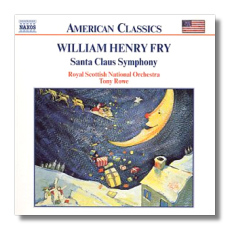
The Internet's Premier Classical Music Source
Related Links
- Fry Reviews
- Latest Reviews
- More Reviews
-
By Composer
-
Collections
DVD & Blu-ray
Books
Concert Reviews
Articles/Interviews
Software
Audio
Search Amazon
Recommended Links
Site News
 CD Review
CD Review
William Henry Fry

Occasional Music
- Santa Claus, Christmas Symphony
- Overture to Macbeth
- Niagara Symphony
- The Breaking Heart
Royal Scottish National Orchestra/Tony Rowe
Naxos 8.559057 DDD 61:13
William Henry Fry, who was born in Philadelphia in 1813, was a sort of Louis Moreau Gottschalk to the American symphony. Showmanship and appeals to American popular taste were central to his methods of composition; the Niagara Symphony was written for a P.T. Barnum "Monster Concert." The upshot is music that is utterly naïve and traditional, yet charming and unaware of its limitations, like a faded postcard from a bygone era.
Santa Claus, Christmas Symphony, was premièred in 1853 by "the eminent musico" (in the words of William S. Gilbert) Louis Antoine Jullien, who was the prototype of today's celebrity conductors. Not a symphony at all, but a 26-minute fantasy, Fry's work depicts the rejoicing of angels, a Christmas Eve party en famille, the gloomy death of a snowbound traveler, a visit from Santa himself, and more. Apparently, the first audience laughed, although it is not clear whether they did so from delight or derision. Fry, a vehement advocate of American music for American audiences, and a music critic to boot, reacted defensively to attacks from fellow critics. He went so far as to refer to the newly founded New York Philharmonic Society as "an incubus on Art" for not having commissioned or performed a single American work during its first 11 years.
It was clever of Fry to write a film score decades before the invention of the motion picture. There's not a tinkle, whoosh, or rattle that isn't illustrative. It's silly, simplistic, and, to be honest, a great deal of fun to hear.
The aforementioned Niagara Symphony was written a year later. Fry brings the cataract to noisy life with a phalanx of eleven timpani and with string scales and tremolos. In the middle of the 14-minute "symphony" (no more deserving of the title than Santa Claus, but so what?), Fry's worshipful chorale defines that era's populist piety. The Breaking Heart is a parlor-ballad swollen to elephantine proportions. Although breaking, this heart is on someone's sleeve, and it might have belonged to Gottschalk's Dying Poet.
In 1864, Fry succumbed to tuberculosis, but not before completing his Overture to Macbeth. Here, in spite of his passionate support of American music, Fry seems to be casting glances across the Atlantic Ocean at Sir Arthur Sullivan. His Overture is a ten-minute précis of Shakespeare's drama, and, its roiling opening for strings notwithstanding, it is neither very violent nor very eerie. Of the four works on this disc, its form is the most sophisticated.
Fry's criticism, particularly his flag-waving, probably has had a greater impact on American music than his music itself. No one can seriously claim that great treasures have been unearthed on this CD. At the same time, fun this innocent and naïve is not easy to come by. Santa Claus, Christmas Symphony might make you laugh, just as audiences laughed almost 150 years ago. In these cynical times, however, we are better equipped to appreciate kitsch than they were.
Fry's music is replete with opportunities for first-chair musicians, even down to the double-bassist, to show their wares, and the Scottish musicians respond without condescension. Overall, the orchestra plays with spirit and affection, and the engineering is very good. This is one of the more unusual entries in Naxos' American Classics series, but it is a worthwhile one nevertheless.
Copyright © 2001, Raymond Tuttle





















